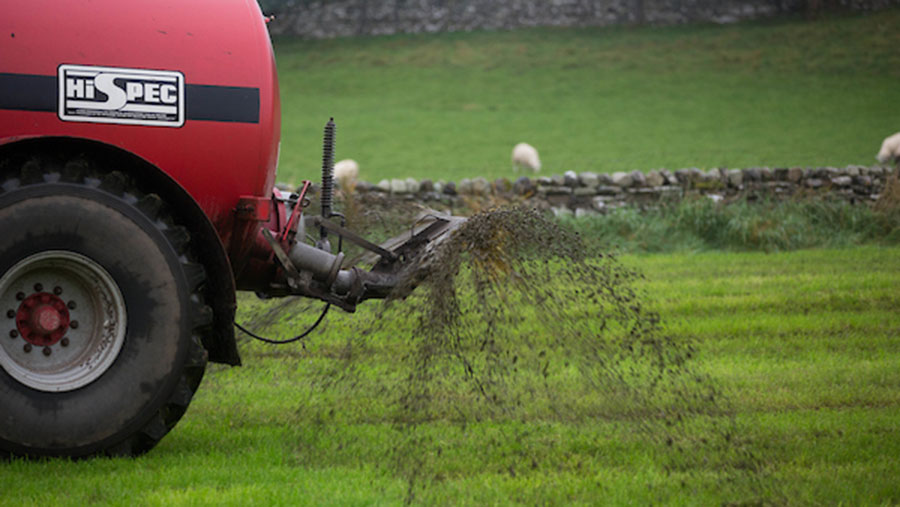Wet weather increases risk of pollution from slurry spreading
 © Tim Scrivener
© Tim Scrivener Farmers are being urged to plan carefully before spreading manure following persistent wet weather since the summer.
The slurry spreading closed period has either already ended or is due to end at the end of the month – depending on where you farm and your soil type.
Farmers are planning fertiliser and manure applications with a watchful eye on the weather and ground conditions to ensure they comply with best practice to prevent any runoff into watercourses.
See also: 13 tips to avoid poisonous gas mixing slurry
It has been a difficult period for slurry management on farms across the UK; wet conditions last summer followed by more wet weather in the autumn left many slurry stores full going into the winter.
Farmers who are concerned that their slurry stores are likely to overspill and that soil conditions may prevent safe slurry spreading should contact their local Environment Agency officer – or equivalent in the devolved regions – as far in advance as possible.
NFU environment adviser Grace Righton said: “These officers will discuss your situation on a case-by-case basis and advise on the best form of action to take, and consider if emergency measures are necessary. They also offer help in drawing up an action plan to avoid future problems.”
Snow-hit farms
Following months of above average rainfall, farms across Scotland and Northern Ireland have been battered by heavy snow in recent days, leaving conditions incompatible to spread slurry.
Slurry and manure rules
- Maintain slurry stores so they do not leak
- Don’t spread slurry or manure (including sewage sludge):
– Within 10m of any inland or coastal waters;
– On waterlogged, frozen or snow-covered ground;
– On shallow soils (average depth less than 40cm over gravel or fissured rock) - Observe relevant closed periods and quantitative restrictions
(Source: Farming & Water Scotland)
Andrew Bauer, deputy director of policy at NFU Scotland, urged farmers and crofters to be aware of current regulation on slurry storage, handling and spreading and do everything possible to minimise the risk of pollution.
“From 1 January, there is a new requirement to not spread slurry when heavy rain is forecast within 24 hours.”
“You should never spread slurry on snow-covered or waterlogged ground.”
In Wales, farmers are being encouraged to stave off the threat of expansion of nitrate vulnerable zones (NVZs) by following guidance on slurry spreading after prolonged wet weather and temporary slurry storage, which is available on the Natural Resources Wales website.
NFU Cymru president John Davies said: “The threat of NVZ regulation hasn’t gone away and the onus is very much on the industry to ensure that water quality is improved right across Wales.”
Slurry mixing dangers
The Health and Safety Executive for Northern Ireland (HSENI) is reminding farmers to take care when mixing slurry.
In recent years, incidents involving slurry have claimed several lives in the province. Many serious incidents have happened as a result of farmers being overcome by poisonous gas, hydrogen sulphide, when mixing.
Malcolm Downey, principal inspector of HSENI’s farm safety team, said farmers must plan ahead before mixing slurry.
“Cover openings and keep children and animals far away during the slurry mixing process,” he said.
“Stay out of the building for at least 30 minutes after the mixing starts and every time you move the pump or change the direction of mixing.”
Slurry spreading guidance following wet weather
The closed period for spreading slurry ended for sandy or shallow soils on 31 December, for farmers in England in a nitrate vulnerable zone (NVZ). The last day of the closed period for all other soils is 31 January.
However, between the end of the closed period and the end of February, farmers must not spread more than 30cu m/ha of slurry or 8t/ha of poultry manure in a single application.
Environment Agency agricultural advisor Tim Bailey said: “The lower rate reduces the risk of leaching and run-though beyond crop use, protecting water from pollution and maximising its value to the following crop. It is recommended farms not in an NVZ do likewise.”
A low rate of 30cu m/ha should prevent the direct loss of slurry through drainage in most situations, he added. However, if rain is forecast shortly after application then there is an added risk of some slurry being washed through.
When in doubt and farmers must spread slurry (for example, to prevent a store over-topping), it should be spread on their lowest risk land, at the lowest possible rate and only what is needed to reduce pressure on the slurry store.
The EA recommends farmers regularly check the condition of stores and make timely repairs when necessary. However, checks must not be at the risk of health and safety, such as from slurry gas.
Slurry storage is governed by Silage, Slurry and Fuel Oil (SSAFO) regulations, with extra requirements for farms in the NVZ zone.
New facilities must have a lifespan of at least 20 years and must be a minimum of 10m from a watercourse.
Charles Mayson, managing director at Cross Compliance Solutions, said: “Slurry stores built before March 1991 are exempt from current SSAFO regulations, but improvements may be required if considered unsafe.”
